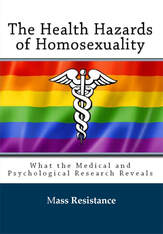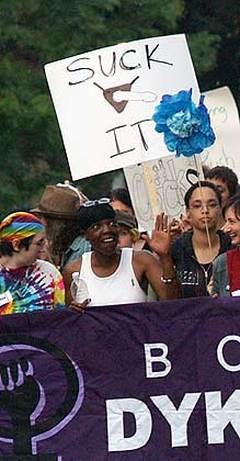
Lesbian Sexual Practices and Disease
(excerpts from Chapters 15, 16, 17)
How Many Women Identify as Lesbian or Bisexual?
The CDC National Survey of Family Growth report showed that 1.2% of females age 18-44 identified as lesbian, and 3.9% as bisexual during the period 2006-2010. The figures increased for the period 2011-2013 to 1.3% lesbian, and 5.5% bisexual.
Beyond those who “self-identify” as lesbian or bisexual, the number of women admitting to sexual activity with another female is increasing. The CDC states, the “percentage of females 18-44 years of age who have ever had any sexual activity with a female partner” was 14.2% for the period 2006-2010, increasing to 17.4% for the period 2011-2013....
By definition, bisexual women engage in sex with men as well as women. But so do many self-identified lesbians. The latest information from the CDC (2015) notes:
Most self-identified WSW [women who have sex with women] (53%-97%) have had sex with men in the past and might continue this practice, with 5%-28% of WSW reporting male partners within the past year....
A 1989 U.S. study showed that among 706 lesbian couples, 27% had been previously married to a man. Research from 1999 summarized, “Results of previous studies indicate that many lesbians have had at least one male sexual partner at some time during their lives.”
There is open “sexual fluidity” among women identifying as lesbians ...
A CDC report (2004) notes, “lesbians commonly report previous pregnancy, induced abortion, and hormonal contraceptive use.” An Australian study (2000) showed,
History of pregnancy, and termination of pregnancy in particular, were more common in WSW [than heterosexual women] (52% versus 44% and 38% versus 27% respectively).
Of lesbians with children under 18 in their home, “64% report that their child was conceived by them as part of a prior opposite-sex relationship.”
The 1987 “Lesbian and Gay Rights” march on Washington platform included as one of seven demands, “Reproductive freedom, the right to control our own bodies,” which was repeated in the 1993 “LGB Equal Rights and Liberation” march. Obviously, many lesbians were/are having sex with men or they would not be concerned about birth control and abortion....
All of these studies show that as a group, many lesbian/bisexual women are exposed to the same health problems stemming from sex with men as are heterosexual women. But some of the men they are involved with may be “gay” or bisexual, further increasing these women’s risk of HIV and other STDs common to MSM.
The public face of lesbian activism, however, denies this frequent sexual engagement with men. The Boston Dyke March serves up a typical performance, with the women holding puerile signs reading:
Fuck Patriarchy – We Recruit – I fuck women – If I wanted a cock I’d get a rooster – Eat at the Y – My girlfriend has a bigger dick than your boyfriend – I kiss girls – Support our boobs – Bois will do bois [“Bois” are “female-to-male” transgenders.]
Occasionally a “bisexual” sign is seen in the mix:
I like girls and GAY boys. ...
The CDC National Survey of Family Growth report showed that 1.2% of females age 18-44 identified as lesbian, and 3.9% as bisexual during the period 2006-2010. The figures increased for the period 2011-2013 to 1.3% lesbian, and 5.5% bisexual.
Beyond those who “self-identify” as lesbian or bisexual, the number of women admitting to sexual activity with another female is increasing. The CDC states, the “percentage of females 18-44 years of age who have ever had any sexual activity with a female partner” was 14.2% for the period 2006-2010, increasing to 17.4% for the period 2011-2013....
By definition, bisexual women engage in sex with men as well as women. But so do many self-identified lesbians. The latest information from the CDC (2015) notes:
Most self-identified WSW [women who have sex with women] (53%-97%) have had sex with men in the past and might continue this practice, with 5%-28% of WSW reporting male partners within the past year....
A 1989 U.S. study showed that among 706 lesbian couples, 27% had been previously married to a man. Research from 1999 summarized, “Results of previous studies indicate that many lesbians have had at least one male sexual partner at some time during their lives.”
There is open “sexual fluidity” among women identifying as lesbians ...
A CDC report (2004) notes, “lesbians commonly report previous pregnancy, induced abortion, and hormonal contraceptive use.” An Australian study (2000) showed,
History of pregnancy, and termination of pregnancy in particular, were more common in WSW [than heterosexual women] (52% versus 44% and 38% versus 27% respectively).
Of lesbians with children under 18 in their home, “64% report that their child was conceived by them as part of a prior opposite-sex relationship.”
The 1987 “Lesbian and Gay Rights” march on Washington platform included as one of seven demands, “Reproductive freedom, the right to control our own bodies,” which was repeated in the 1993 “LGB Equal Rights and Liberation” march. Obviously, many lesbians were/are having sex with men or they would not be concerned about birth control and abortion....
All of these studies show that as a group, many lesbian/bisexual women are exposed to the same health problems stemming from sex with men as are heterosexual women. But some of the men they are involved with may be “gay” or bisexual, further increasing these women’s risk of HIV and other STDs common to MSM.
The public face of lesbian activism, however, denies this frequent sexual engagement with men. The Boston Dyke March serves up a typical performance, with the women holding puerile signs reading:
Fuck Patriarchy – We Recruit – I fuck women – If I wanted a cock I’d get a rooster – Eat at the Y – My girlfriend has a bigger dick than your boyfriend – I kiss girls – Support our boobs – Bois will do bois [“Bois” are “female-to-male” transgenders.]
Occasionally a “bisexual” sign is seen in the mix:
I like girls and GAY boys. ...

Lifestyle and Disease Risk
Lesbians and bisexual women as a group display higher incidence of psychological dysfunction: depression, anxiety, mood disorders, suicidal behaviors, etc. They also have problematic lifestyle issues including short-lived relationships, substance abuse, partner abuse, and absence of pregnancy, and sometimes abortion.
Since increasing numbers of women and girls are self-identifying as (or behaving as) bisexual, this means they have a risk of acquiring a wide range STDs from their male partners, then further transmitting disease to their female partners (and other male partners). ... many self-identified lesbians also engage in sex with men.
In 2016, the American Medical Association JAMA Internal Medicine published a study using statistics on GLB adults from the 2013 and 2014 National Health Interview Survey. It revealed:
... lesbian women were more likely to report moderate psychological distress … poor or fair health … multiple chronic conditions … heavy drinking … heavy smoking … than heterosexual women; and bisexual women were more likely to report multiple chronic conditions … severe psychological distress … heavy drinking … and moderate smoking … than heterosexual women....
Areas of elevated health concerns for lesbians are noted by the GLMA (Gay & Lesbian Medical Association):
… increased risk for breast cancer, depression/anxiety, heart health, gynecological cancer, poor fitness, high levels of alcohol and tobacco use, and STDs....
Some women who first identify as lesbian later change their identity to “transgender” – risking long-term damage from opposite-sex hormone treatments, body-disfiguring surgeries, and further psychological distress.
Mental Health, Partner Abuse
In 2016, the American Medical Association’s JAMA Internal Medicine published a study using statistics on GLB adults from the 2013 and 2014 National Health Interview Survey (the first to include “sexual orientation” of the respondents):
Approximately 21.9% of heterosexual women exhibited symptoms of moderate and severe psychological distress, but the prevalence of moderate and severe psychological distress was higher among lesbian women (28.4%) and twice as high (46.4%) among bisexual women…
A large population-based study showed that lesbian and bisexual women had experienced disproportionate “prevalent and persistent abuse” as children. Abuse often does not end in childhood for many in the lesbian community, and their higher rates of partner abuse and violence surely contribute to psychological stress.
Lesbians and bisexual women as a group display higher incidence of psychological dysfunction: depression, anxiety, mood disorders, suicidal behaviors, etc. They also have problematic lifestyle issues including short-lived relationships, substance abuse, partner abuse, and absence of pregnancy, and sometimes abortion.
Since increasing numbers of women and girls are self-identifying as (or behaving as) bisexual, this means they have a risk of acquiring a wide range STDs from their male partners, then further transmitting disease to their female partners (and other male partners). ... many self-identified lesbians also engage in sex with men.
In 2016, the American Medical Association JAMA Internal Medicine published a study using statistics on GLB adults from the 2013 and 2014 National Health Interview Survey. It revealed:
... lesbian women were more likely to report moderate psychological distress … poor or fair health … multiple chronic conditions … heavy drinking … heavy smoking … than heterosexual women; and bisexual women were more likely to report multiple chronic conditions … severe psychological distress … heavy drinking … and moderate smoking … than heterosexual women....
Areas of elevated health concerns for lesbians are noted by the GLMA (Gay & Lesbian Medical Association):
… increased risk for breast cancer, depression/anxiety, heart health, gynecological cancer, poor fitness, high levels of alcohol and tobacco use, and STDs....
Some women who first identify as lesbian later change their identity to “transgender” – risking long-term damage from opposite-sex hormone treatments, body-disfiguring surgeries, and further psychological distress.
Mental Health, Partner Abuse
In 2016, the American Medical Association’s JAMA Internal Medicine published a study using statistics on GLB adults from the 2013 and 2014 National Health Interview Survey (the first to include “sexual orientation” of the respondents):
Approximately 21.9% of heterosexual women exhibited symptoms of moderate and severe psychological distress, but the prevalence of moderate and severe psychological distress was higher among lesbian women (28.4%) and twice as high (46.4%) among bisexual women…
A large population-based study showed that lesbian and bisexual women had experienced disproportionate “prevalent and persistent abuse” as children. Abuse often does not end in childhood for many in the lesbian community, and their higher rates of partner abuse and violence surely contribute to psychological stress.
Sexual Practices
For the most part, the more “traditional” lesbian and bisexual women’s (WSW) sexual practices (e.g., tribadism, kissing, cunnilingus) are less risky than MSM practices. However, STDs can still be spread through these sorts of sexual contact.
What has changed recently is that many lesbians are imitating the more dangerous MSM practices (e.g., rimming, anal play, fisting, and anal penetration with dildos). Furthermore, WSW who have sexual contact with men court even more risk. ...
Many WSW ignore “safer sex” advice, according to the Women’s Institute (at Gay Men’s Health Crisis):
Lesbians and bisexual women, like their heterosexual counterparts, engage in at-risk sexual and social behaviors that place them at high risk, including but not limited to: unprotected sex with men, an increased number of sexual partners, the use of injection drugs, and exposure to fluids known to transmit HIV i.e. menstrual blood, vaginal secretions. Research from 1992 has shown that while a number of women (81%) believe that safe sex is important, only a few (18.7%) actually practiced it when engaged in sexual activity with other women (Russell et al. 1992). More than a decade later, this continues to be a reality for a [sic] many lesbians/WSW.
For the most part, the more “traditional” lesbian and bisexual women’s (WSW) sexual practices (e.g., tribadism, kissing, cunnilingus) are less risky than MSM practices. However, STDs can still be spread through these sorts of sexual contact.
What has changed recently is that many lesbians are imitating the more dangerous MSM practices (e.g., rimming, anal play, fisting, and anal penetration with dildos). Furthermore, WSW who have sexual contact with men court even more risk. ...
Many WSW ignore “safer sex” advice, according to the Women’s Institute (at Gay Men’s Health Crisis):
Lesbians and bisexual women, like their heterosexual counterparts, engage in at-risk sexual and social behaviors that place them at high risk, including but not limited to: unprotected sex with men, an increased number of sexual partners, the use of injection drugs, and exposure to fluids known to transmit HIV i.e. menstrual blood, vaginal secretions. Research from 1992 has shown that while a number of women (81%) believe that safe sex is important, only a few (18.7%) actually practiced it when engaged in sexual activity with other women (Russell et al. 1992). More than a decade later, this continues to be a reality for a [sic] many lesbians/WSW.

Lesbians often use dildos. In these photos, a woman displays her "strap-on" dildo at a San Francisco street fair. The "SUCK IT" sign at Boston Dyke March confirms that "artificial fellatio" on a strap-on dildo is a variation on the penis-substitute theme. (Photos: Americans for Truth about Homosexuality and MassResistance.) |
Many lesbians are imitating another very dangerous male homosexual practice: fisting.
Fisting is now a “popular lesbian sex act,” according to Huffington Post’s lesbian pornographer. The New England Leather Alliance (non-profit BDSM “educational” group) has offered instruction on vaginal and anal fisting:
Vaginal and Anal Fisting 101: A fistful of fun.
The ins and outs of fisting! Vaginal, anal, double fisting, fisting each other at the same time, lubes, enemas, relaxing the fistee, fear play, developing a scene around fisting, restraint, safety, negotiation techniques and more!
At Boston Pride’s “Dyke March” (June 2012) a sign read, “Fists are for fuckin, not fightin.” Also at that annual lesbian event, identity stickers were handed out reading, “Top” and “Bottom" (BDSM power terms, indicating the women are fans of rough sadomasochistic practices such as fisting).
Fisting is now a “popular lesbian sex act,” according to Huffington Post’s lesbian pornographer. The New England Leather Alliance (non-profit BDSM “educational” group) has offered instruction on vaginal and anal fisting:
Vaginal and Anal Fisting 101: A fistful of fun.
The ins and outs of fisting! Vaginal, anal, double fisting, fisting each other at the same time, lubes, enemas, relaxing the fistee, fear play, developing a scene around fisting, restraint, safety, negotiation techniques and more!
At Boston Pride’s “Dyke March” (June 2012) a sign read, “Fists are for fuckin, not fightin.” Also at that annual lesbian event, identity stickers were handed out reading, “Top” and “Bottom" (BDSM power terms, indicating the women are fans of rough sadomasochistic practices such as fisting).
Lesbian Health Concerns
Areas of elevated health concerns for lesbians and bisexual women are noted by many public health agencies and GLB-affirming groups.
The Substance Abuse and Mental Health Services Administration (HHS) notes the “Top Health Issues for Lesbians” and lists heart disease, cancers, fitness, obesity, injury (from intimate partner violence), mental health, suicide, and substance abuse.
The GLMA (Gay & Lesbian Medical Association) lists the “top 10 things lesbians should discuss with their healthcare provider”: breast cancer, depression/anxiety, heart health, gynecological cancer, fitness, tobacco use, alcohol use, drug use, intimate partner violence, and STDs. ...
Many of the STDs among lesbians and bisexual women are connected to unsafe sexual practices ... including anal contact, use of “penetrative sex items,” as well as sex with men. From the CDC:
Few data are available on the risk for STDs conferred by sex between women, but transmission risk probably varies by the specific STD and sexual practice (e.g., oral-genital sex; vaginal or anal sex using hands, fingers, or penetrative sex items; and oral-anal sex). Practices involving digital-vaginal or digital-anal contact, particularly with shared penetrative sex items, present a possible means for transmission of infected cervicovaginal or anal secretions. This possibility is most directly supported by reports of shared trichomonas infections and by concordant drug resistance genotype testing and phylogenetic linkage analysis identifying HIV transmitted sexually between women. Most self-identified WSW (53%–97%) have had sex with men in the past and might continue this practice, with 5%–28% of WSW reporting male partners within the past year.
The Public Health Agency of Canada confirms health discrepancies for lesbian and bisexual women, compared to heterosexual women. Note that when WSW have sex with men, it is often with homosexual or bisexual men. ...
Areas of elevated health concerns for lesbians and bisexual women are noted by many public health agencies and GLB-affirming groups.
The Substance Abuse and Mental Health Services Administration (HHS) notes the “Top Health Issues for Lesbians” and lists heart disease, cancers, fitness, obesity, injury (from intimate partner violence), mental health, suicide, and substance abuse.
The GLMA (Gay & Lesbian Medical Association) lists the “top 10 things lesbians should discuss with their healthcare provider”: breast cancer, depression/anxiety, heart health, gynecological cancer, fitness, tobacco use, alcohol use, drug use, intimate partner violence, and STDs. ...
Many of the STDs among lesbians and bisexual women are connected to unsafe sexual practices ... including anal contact, use of “penetrative sex items,” as well as sex with men. From the CDC:
Few data are available on the risk for STDs conferred by sex between women, but transmission risk probably varies by the specific STD and sexual practice (e.g., oral-genital sex; vaginal or anal sex using hands, fingers, or penetrative sex items; and oral-anal sex). Practices involving digital-vaginal or digital-anal contact, particularly with shared penetrative sex items, present a possible means for transmission of infected cervicovaginal or anal secretions. This possibility is most directly supported by reports of shared trichomonas infections and by concordant drug resistance genotype testing and phylogenetic linkage analysis identifying HIV transmitted sexually between women. Most self-identified WSW (53%–97%) have had sex with men in the past and might continue this practice, with 5%–28% of WSW reporting male partners within the past year.
The Public Health Agency of Canada confirms health discrepancies for lesbian and bisexual women, compared to heterosexual women. Note that when WSW have sex with men, it is often with homosexual or bisexual men. ...
The banner at the radical feminist website Feministing shows a female figure with her hand in the insertion position for vaginal or anal fisting.

